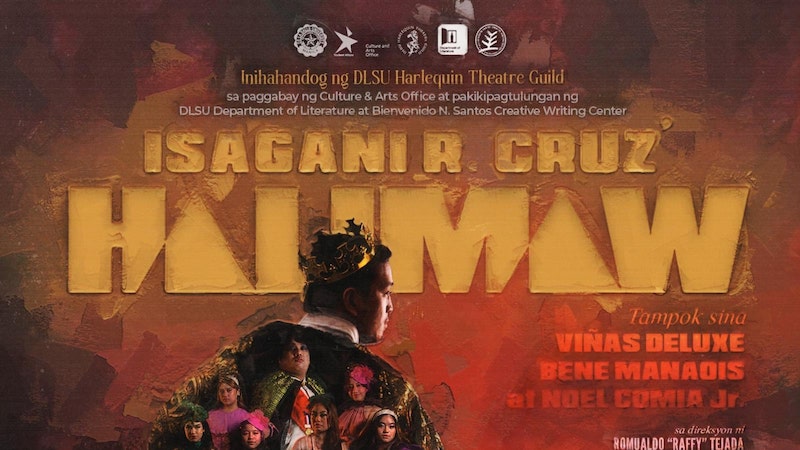
UNI REVIEW: DLSU Harlequin Theatre Guild’s ‘Halimaw’
This satirical zarzwela—following a lowly janitor on an odyssey to find the king’s three missing daughters—delivers on its promises of talented guest stars and colorful visual design.
Ambition isn’t lacking in the university theater space, and it will always be admirable to see relatively inexperienced theater practitioners stretch to the very limits of their budget—even more so to see young people use their resources towards pointedly political material. And the De La Salle University – Manila’s Harlequin Theatre Guild clearly has a vision for its production of Isagani R. Cruz’s Halimaw. But with ambition comes the challenge of executing so many tricky moving parts. On one hand, this satirical zarzwela—following a lowly janitor on an odyssey to find the king’s three missing daughters—delivers on its promises of talented guest stars and colorful visual design. Unfortunately, the press preview attended by this writer was also beset by missed cues, technical hitches, and a general lack of focus that prevented this already thin story from being able to comment on Filipino nationhood in a coherent way.
Confident in Its Strengths
To its credit, the student organization putting up this musical seems to know exactly what Halimaw’s strengths are; its loudest and most high-profile elements are great fun when regarded separately from the rest of the show. Leeroy New’s multi-level set is practically a doll house full of different entrances and detachable parts, keeping the movement on stage fairly unpredictable as the story moves from one location to another. And Santi Obcena’s eclectic costume and makeup design communicates the idea of diverse peoples, cultures, and social classes—all through a general DIY style combining uniforms, historical and contemporary outfits, drag, and exaggerated prop work.
Some of Halimaw’s most visually memorable characters are also its best-performed. As the king, Bene Manaois is effortlessly whimsical and cruel in the same moments. Drag performer Viñas DeLuxe has stage presence for days, unencumbered by her Sirena’s large, puppeteered appendages protruding from her costume. And Murline Uddin’s Ursula-esque Purista has the charisma to match her ridiculous dress and tentacles made of fabric and plastic bottles. Among the younger players, Devs de Vera’s Mensahero shows up like a firecracker, rapping with as much confidence as the Hamilton cast at Solaire. And in the lead as janitor-hero Alberto, TV star Noel Comia, Jr. falters with the show’s comedy, but has enough spirit to get back from these misjudged moments.
Clutter and Lack of Polish
Despite these individual standouts, however, the production can’t corral all of its components into a meaningful whole. Halimaw’s direction simply doesn’t pay enough attention to the details, which leads to messy storytelling and a stage cluttered with visual noise. The large ensemble is often blocked in such a way that just makes them a distraction to the focal points of each scene, while lines of dialogue step over each other without any real cadence. This is most noticeable in the musical’s jokes, very few of which actually land. A scene, for example, in which Alberto answers three riddles with the help of a magical watch is performed with little comedic timing—each obvious punchline being delivered without momentum, as the character stands awkwardly to one side the entire time.
The lack of polish during the preview show was significant enough to get in the way of the entire experience. Awkward silences due to missed cues, microphones not being switched on in time, severely delayed lighting changes and spotlights, stagehands visibly moving across the stage in full view—all of these things really do hurt the final product, even if they may seem small in isolation.
Scattershot Storytelling
It doesn’t help that Isagani Cruz’s script is built on broad character types, which means a deft touch is needed to really bring out deeper meaning. Unfortunately, the metaphors at the heart of this story—about the impossibility of finding one true Filipino identity and the importance of decentralizing power—get buried under its scattershot storytelling. Vince Lim’s score, while (again) effective when taken song by song, doesn’t congeal as a unified body of work, with musical numbers deployed at an oddly inconsistent rate. Songs that are meant to develop significant character relationships aren’t very convincing, and the overall plot just begins to plod along far too slowly.
By the time Halimaw attempts to put a dark spin to its supposed fairytale ending, it comes off as completely unearned. It’s a twist devoid of any dramatic tension, delivered in a way that feels like a betrayal of all of its characters’ intelligence. It shouldn’t be a spoiler to say that the show then concludes with the singing of the Lupang Hinirang—a choice that’s both incredibly heavy-handed and incredibly vague in its intent. Productions that aim to make sweeping statements about the Philippines are tricky for any theater company to pull off, and for all of its valiant ambition, this musical doesn’t crack the code either.


Comments